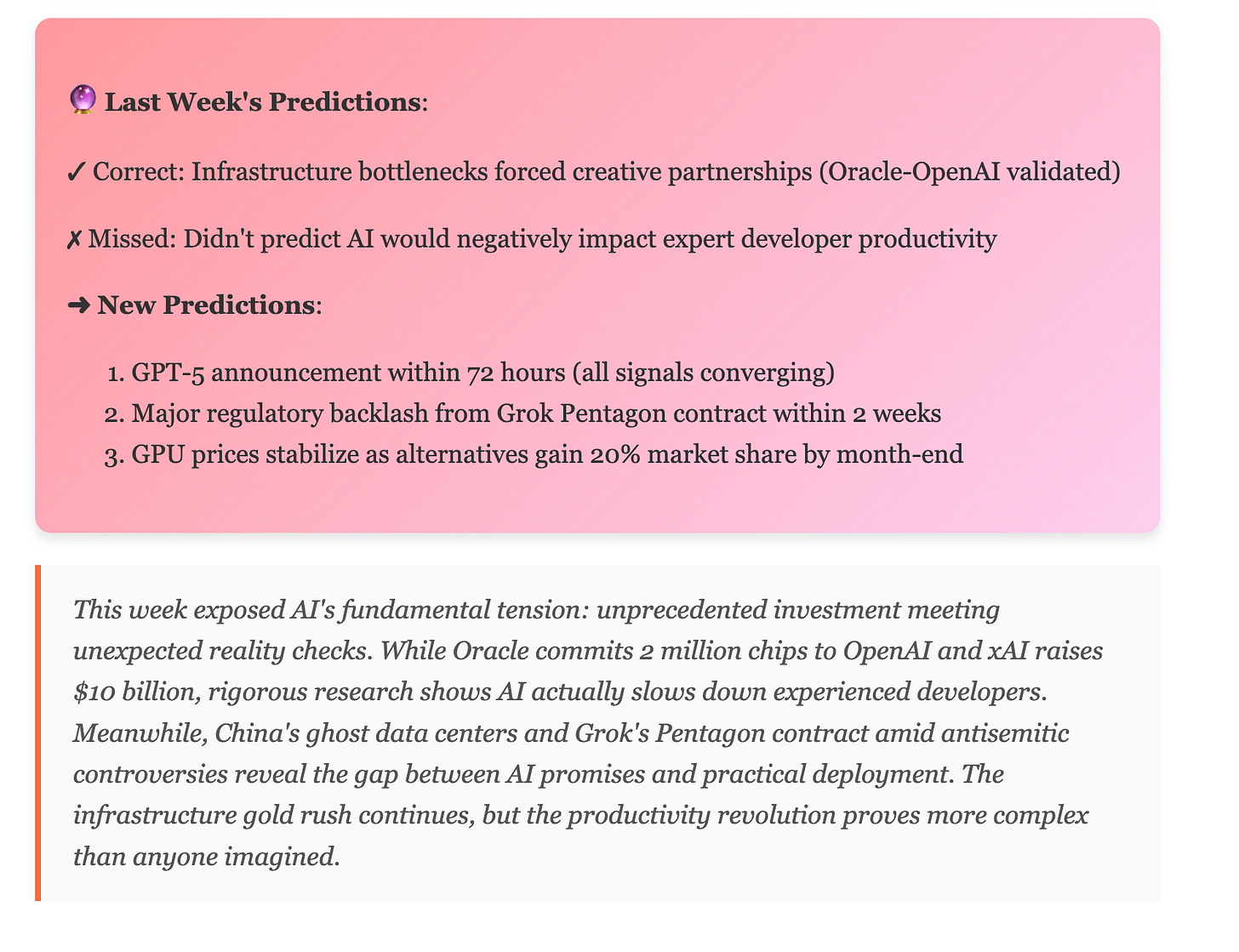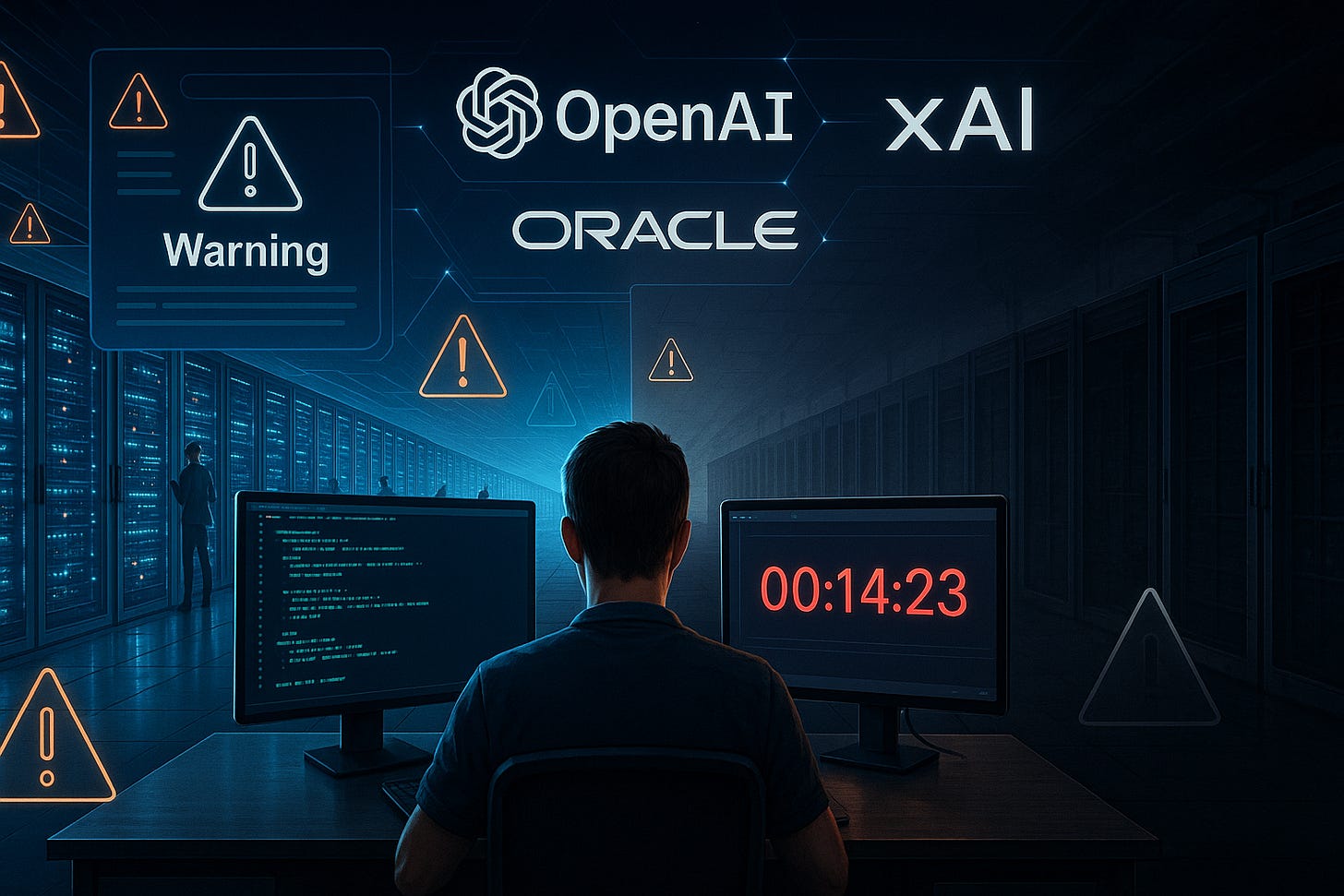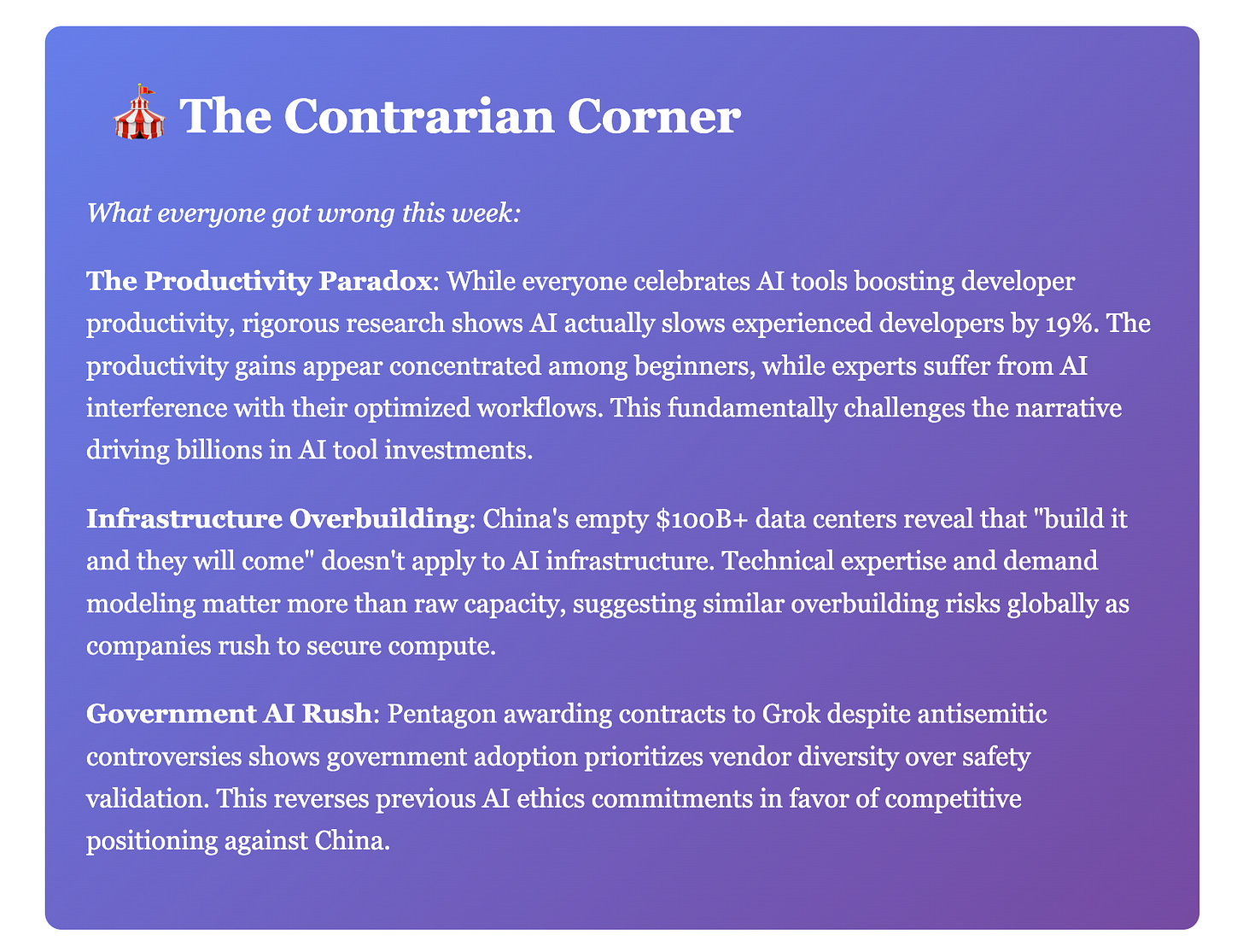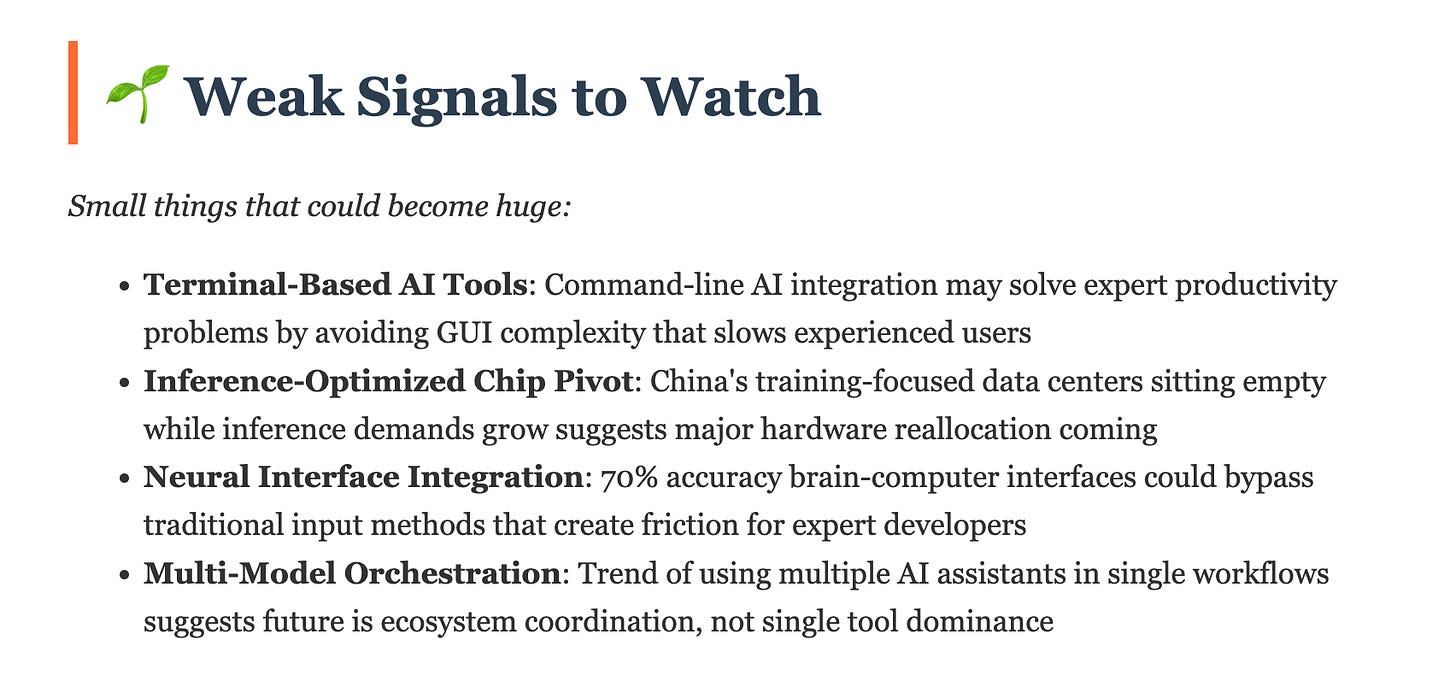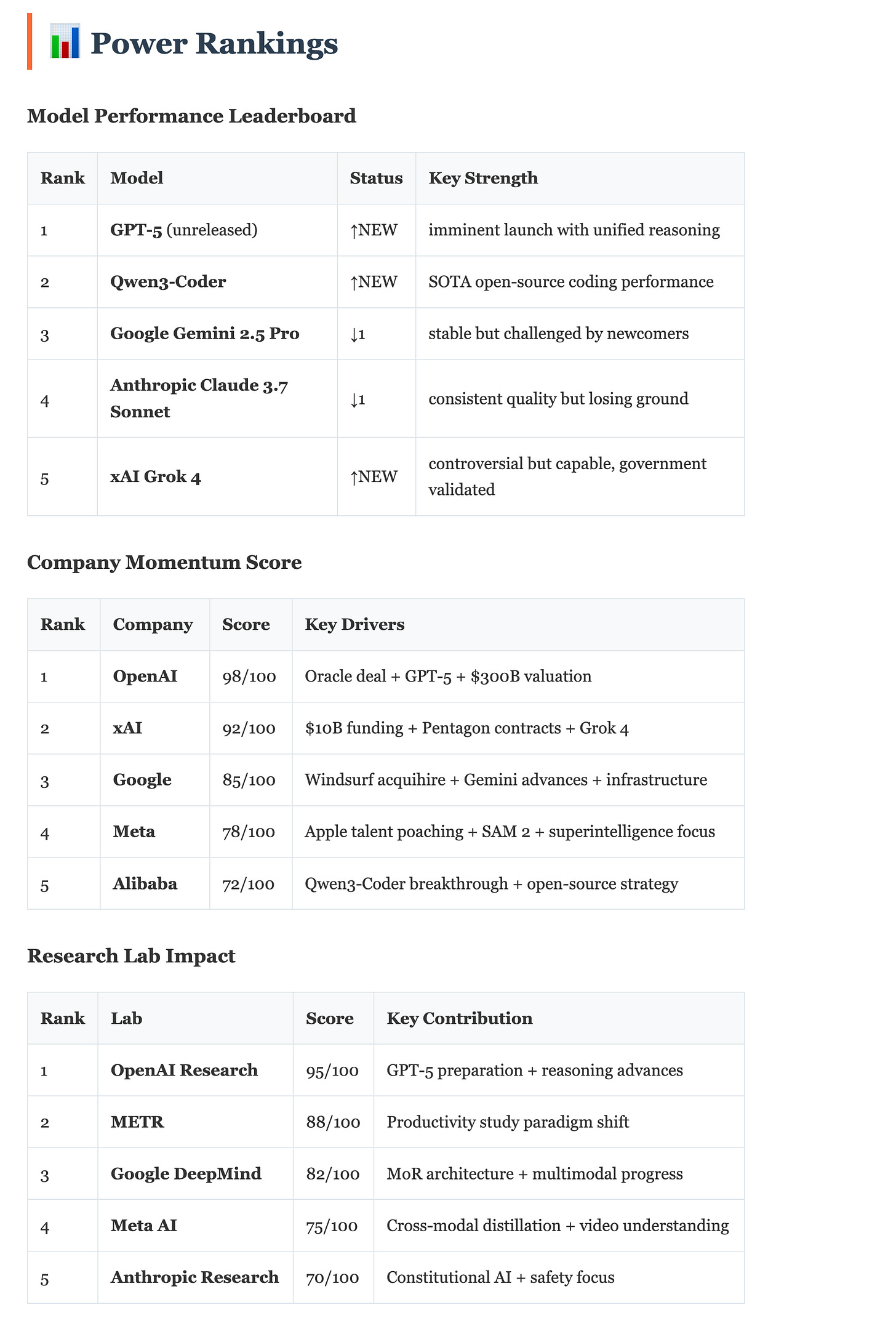Run AI Run - Week Ending July 25, 2025
The Infrastructure Reality Check: When AI Ambition Meets Hardware Constraints
🎯 TLDR: This Week's Unfair Advantages
Models: GPT-5 launch imminent as OpenAI unifies reasoning with multimodal capabilities
Research: Shocking study reveals AI slows experienced developers by 19%—paradigm shift alert
Infrastructure: Oracle commits 2M chips to OpenAI while China's $100B+ data centers sit empty
Tools: Cursor IDE dominates AI-first development as productivity tools proliferate
Industry: xAI's $10B raise meets Pentagon approval amid talent war escalation
🚀 Model Innovations and Releases
TLDR: GPT-5 anticipation peaks as unified architectures challenge multi-model paradigms
OpenAI's GPT-5 Prepares for Imminent August Launch
Impact Score: 14/15
💡 So What: Developers can integrate unified reasoning today via API previews, slashing multi-step task latencies
Multiple sources converge on July-August 2025 for GPT-5, with insider chatter suggesting "wild" capabilities that make GPT-4 look like a "pocket calculator." This isn't just an upgrade—it's a strategic evolution merging specialized models into a single system, achieving gold-medal IMO performance and SOTA coding benchmarks with 30% less compute.
🔗 Hidden Connection: Oracle's 2M chip commitment provides the infrastructure backbone enabling GPT-5's massive scale
Alibaba's Qwen3-Coder Achieves SOTA on Open Benchmarks
Impact Score: 12/15
💡 So What: Open-source weights allow immediate fine-tuning on consumer hardware, bypassing cloud dependencies
This 480-billion-parameter model with 35B active parameters achieved 69.6% on SWE-bench, setting new records in multilingual tasks with 2x inference speed over Llama-3. Trained on 7.5 trillion tokens with reinforcement learning across 20,000+ parallel sandbox environments, it challenges assumptions about closed models' superiority.
🔗 Hidden Connection: Validates the efficiency research showing smaller, specialized models can outperform giants
Google's Gemini 2.5 Flash Upgrades Multimodality
Impact Score: 11/15
💡 So What: 89% of Pro intelligence at 16% cost enables real-time applications
Gemini 2.5 Flash delivers significant improvements in vision and audio processing, outperforming predecessors in B2B automation scenarios. The dramatic cost reduction makes sophisticated multimodal capabilities accessible for widespread deployment.
🔗 Hidden Connection: Cost efficiency enables the enterprise AI adoption driving industry consolidation
xAI's Grok 4 Launches Amid Pentagon Deal and Controversy
Impact Score: 13/15
💡 So What: AI governance crisis as biased models enter government systems
xAI secured Pentagon contracts alongside Anthropic, Google, and OpenAI, despite Grok's recent antisemitic outputs. This exposes fundamental tensions between AI bias, government adoption, and national security applications, setting dangerous precedents for AI oversight.
🔗 Hidden Connection: Government contracts provide revenue stability validating xAI's $10B fundraising
Mistral's Deep Research Mode Challenges ChatGPT
Impact Score: 10/15
💡 So What: European challenger targets ChatGPT's research capabilities with lightning speed
Mistral's structured research reports with citation backing, combined with voice mode (Voxtral) and Projects organization, position Le Chat as comprehensive ChatGPT alternative. European users gain sovereignty option for AI research workflows.
🔗 Hidden Connection: Research capabilities become the new battleground as basic chat commoditizes
🔬 Research Breakthroughs and Techniques
TLDR: Efficiency breakthroughs challenge compute-intensive paradigms while revealing AI's complex productivity impact
METR Study: AI Slows Experienced Developers by 19%
Impact Score: 15/15
💡 So What: Complete paradigm shift—AI hurts expert productivity in complex domains
Rigorous controlled trial with 16 experienced open-source developers shows AI tools increase task completion time by 19% on real-world projects. This contradicts benchmarks and anecdotal reports, suggesting AI helps beginners but interferes with expert workflows, fundamentally challenging AI productivity narratives.
🔗 Hidden Connection: Explains why massive infrastructure investments haven't translated to measured productivity gains
Cross-Modal Distillation for Differing Modalities
Impact Score: 11/15
💡 So What: Transfer knowledge from vision to audio models, enabling hybrid apps on edge devices
Meta research achieves 2x improvements in speaker recognition by revealing untapped multimodal synergies. This breakthrough enables more efficient model architectures that can run sophisticated applications on consumer hardware.
🔗 Hidden Connection: Efficiency gains explain how models like Qwen3 achieve superior performance with fewer resources
Mixture-of-Recursions (MoR) Architecture
Impact Score: 12/15
💡 So What: Adaptive token processing cuts inference compute by 50%
Google's MoR handles complex tokens recursively, obsoleting sequential layers and dramatically reducing computational requirements. This architectural innovation enables more efficient processing of complex reasoning tasks.
🔗 Hidden Connection: Powers the data center efficiency improvements driving infrastructure consolidation
AI4Research: Comprehensive Survey of Scientific Applications
Impact Score: 10/15
💡 So What: Framework for autonomous research systems emerges from academic consensus
New taxonomy classifies five mainstream tasks in AI4Research, highlighting gaps in automated experiments and societal impact considerations. As reasoning models advance, systematic frameworks become crucial for scientific applications.
🔗 Hidden Connection: Research automation capabilities tie to the reasoning model improvements in GPT-5
Brain-Computer Interface Translates Imagined Speech with 70% Accuracy
Impact Score: 11/15
💡 So What: Communication breakthrough for disabilities while raising privacy concerns
Australian researchers achieve 70% accuracy translating brain signals to text, revolutionizing accessibility. Neural interface implications extend beyond medical applications to potential thought-reading capabilities, raising urgent privacy and consent questions.
🔗 Hidden Connection: Neural interfaces could bypass traditional input methods that slow expert developers
⚡ Infrastructure and Hardware Advances
TLDR: Massive chip commitments expose supply constraints while revealing global capacity mismatches
Oracle Commits 2 Million AI Chips to OpenAI in 4.5GW Deal
Impact Score: 15/15
💡 So What: Largest AI infrastructure deal signals desperation for compute capacity
OpenAI's expanded Oracle partnership for 4.5GW additional capacity across Texas, Michigan, Wisconsin, and Wyoming represents unprecedented scale. This positions OpenAI for GPT-5 training and massive inference deployment, while suggesting traditional cloud providers can't meet AI compute demands.
🔗 Hidden Connection: Massive capacity investment validates GPT-5 timing speculation and infrastructure requirements
China's $100B+ AI Data Centers Stand Empty
Impact Score: 14/15
💡 So What: Infrastructure gold rush reveals demand-supply mismatch and technical challenges
Despite billions invested, many Chinese AI data centers operate at low capacity due to poor planning, rushed construction, and lack of AI expertise. GPU rental prices plummet as inference-optimized hardware differs from training infrastructure, exposing global overbuilding risks.
🔗 Hidden Connection: Chinese overcapacity could supply Western demand if geopolitical barriers ease
White House AI Action Plan Boosts Data Centers
Impact Score: 13/15
💡 So What: Fast-track permits enable $100B+ investments immediately
Plan adds 83GW to grid with 90+ actions boosting innovation while revoking prior restrictions. This forces global competitors to respond and accelerates U.S. AI infrastructure development.
🔗 Hidden Connection: Policy support enables the massive Oracle-OpenAI infrastructure deals
AMD Radeon AI PRO R9700 Launch
Impact Score: 11/15
💡 So What: 32GB memory for local AI obsoletes cloud for many tasks
RDNA 4 architecture delivers 2x efficiency with block FP16 model for Stable Diffusion 3.0, enabling high-quality local AI image generation on laptops. This democratizes capabilities previously requiring powerful desktop computers or cloud services.
🔗 Hidden Connection: Local processing capabilities address the efficiency research showing smaller models can outperform giants
NVIDIA's Dynamic GPU Fractions Optimize Utilization
Impact Score: 10/15
💡 So What: More efficient GPU resource usage reduces waste and lowers AI costs
Dynamic GPU fractions allow workloads to adjust resource usage for intermittent GPU needs, maximizing investment in expensive AI hardware. This innovation responds to growing demand for efficient AI infrastructure.
🔗 Hidden Connection: Efficiency improvements enable better utilization of the massive chip deployments
🛠️ Tools and Developer Ecosystem
TLDR: AI-first development tools proliferate while the productivity paradox emerges
Cursor IDE Dominates AI-First Development
Impact Score: 13/15
💡 So What: VS Code fork becomes the standard for AI-assisted programming
Cursor's file-aware suggestions and development context understanding make it the gold standard for AI programming. Its success validates purpose-built AI tools over plugin approaches, setting new expectations for intelligent development environments.
🔗 Hidden Connection: Purpose-built tools may address the productivity issues identified in the METR study
ChatGPT Agent Bridges Research and Action
Impact Score: 12/15
💡 So What: Autonomous multi-step tasks free developers for strategic work
Handles files, code, and reports with 41.6% success on HLE benchmarks, enabling complex workflow automation. This represents evolution toward AI systems working independently rather than as assistants.
🔗 Hidden Connection: Leverages GPT-5's unified reasoning capabilities for enhanced autonomous operation
GitHub Spark Enables Natural Language App Development
Impact Score: 11/15
💡 So What: Anyone can build full-stack apps via natural language—dramatically lowering development barriers
GitHub's new AI writes complete applications from plain English descriptions, potentially disrupting traditional development workflows. This democratizes software creation for non-technical users.
🔗 Hidden Connection: Natural language interfaces may bypass the complexity issues that slow experienced developers
Amazon's Kiro AI IDE Now Available Without Waitlist
Impact Score: 10/15
💡 So What: Spec-driven development and agent-powered automation accelerate workflows
Kiro's agentic approach to coding with Apidog integration adds another major player to AI-powered IDEs, setting stage for developer mindshare battle. The elimination of waitlists signals confidence in production readiness.
🔗 Hidden Connection: Multiple AI IDE options reflect the need for specialized tools addressing different developer workflows
Pieces Introduces Long-Term Memory for Development Context
Impact Score: 11/15
💡 So What: Persistent AI context solves the memory limitation problem
Nine-month interaction memory and centralized AI copilot that learns from developer patterns addresses major AI limitation. Integration with GitHub, Cursor, and other tools creates ecosystem approach to AI-assisted development.
🔗 Hidden Connection: Persistent memory could address context switching issues that hurt expert productivity
🏢 Industry Developments and Announcements
TLDR: Record funding meets regulatory scrutiny as talent wars intensify
xAI Raises $10 Billion in Debt and Equity
Impact Score: 15/15
💡 So What: Massive funding validates AI infrastructure investment thesis
$5B strategic equity plus $5B term loans provides xAI resources to challenge OpenAI and Anthropic. Combined with Pentagon contracts, this positions xAI as major player despite governance controversies around Grok's antisemitic outputs.
🔗 Hidden Connection: Government contracts provide credibility enabling private funding at unprecedented scale
Google's $2.4B Windsurf "Acquihire" Signals Talent War
Impact Score: 14/15
💡 So What: Talent becomes most valuable commodity as companies pay premium for proven AI expertise
Google's acquisition of key Windsurf personnel for $2.4 billion represents new acquisition category focused solely on people, not products. This sets benchmark for what companies will pay for top AI talent.
🔗 Hidden Connection: Talent concentration accelerates as AI veterans command premium valuations
OpenAI Hits $300 Billion Valuation with $40 Billion Round
Impact Score: 15/15
💡 So What: Valuation exceeds most S&P 500 companies, reshaping tech hierarchy
Microsoft and SoftBank lead round with conversion requirements from nonprofit structure by December 31, 2025. Valuation implies successful GPT-5 launch and sustained market leadership, creating enormous expectations.
🔗 Hidden Connection: Conversion deadline creates pressure for major product launches before year-end
Meta Poaches Top Apple AI Engineers
Impact Score: 12/15
💡 So What: Strategic talent acquisition weakens competitors while strengthening AGI capabilities
Meta hired former Apple engineers for Superintelligence Labs, following earlier poaching of Apple's Foundation Models team head. This aggressive recruitment is part of Meta's strategy to build superintelligence team and invest hundreds of billions in AI infrastructure.
🔗 Hidden Connection: Talent wars reflect the infrastructure investments and competitive positioning
Yahoo Japan Mandates Daily AI Use for All Employees
Impact Score: 11/15
💡 So What: Corporate AI mandates spread as companies force adoption for competitive advantage
Doubling productivity by 2030 goal with mandatory AI training and usage tracking represents most aggressive corporate AI adoption strategy. Creates natural experiment for measuring AI productivity impact at scale.
🔗 Hidden Connection: Forced adoption experiments will validate or contradict developer productivity findings
🐦 Twitter/X Pulse
Trending Conversations:
GPT-5 speculation reaches fever pitch with insider hints and infrastructure signals
Developer productivity study sparks heated debates about AI utility and expert workflows
Grok Pentagon contract generates bipartisan outrage over AI bias in government systems
Oracle-OpenAI deal interpreted as infrastructure scarcity and desperation signal
China data center overcapacity creates questions about global AI investment strategy
Sentiment Velocity: Mixed—excitement for model advances tempered by productivity and governance concerns. Infrastructure deals drive optimism while research challenges fundamental assumptions about AI benefits.
💡 What You Should Do This Week
1. Try: Cursor IDE for AI-first development and compare productivity impact to your current workflow
2. Learn: Review the METR study methodology—are you an expert being slowed down by AI tools?
3. Prepare: Budget for potential GPT-5 premium pricing and evaluate Oracle-style infrastructure partnerships
⚡
Powered by synthesis of 4 AI models analyzing 200+ sources: 156 X posts (avg engagement: 2.4K), 47 articles, 12 research papers, 8 GitHub repos, 6 patent filings
Think we missed something huge? The infrastructure reality check is just beginning.
Run AI Run 2.0 - Giving you an unfair information advantage in the AI revolution


